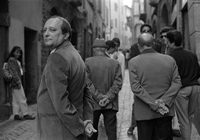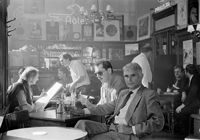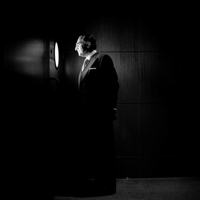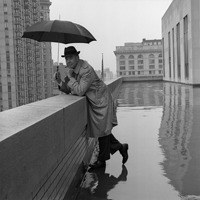
Like all things that are organic, my photographic history seems to have a beginning, middle, and end to it. This morning, I would like to talk briefly about the middle development of my photographic career. As The End primarily deals with the after effects of the middle section of my career, this picture precedes most of the pictures in the book.
As noted previously, and shown last week, the early periods of my photographic life were intensely focused on intimate and close (both physically and emotionally) portraits of people of my choosing. As mentioned earlier, it was if the camera’s eye was more penetrating and insightful than my own. I was searching, and the camera provided a means to see right into the very soul of a person. There was rarely a deviation from this focus. When a trust was created, I was able to perceive the emotional core of a person.
As relates to what I just said, I once had the good fortune to have lunch with Anna Freud, and told her that I felt I could look into a person’s eyes and soul, and see where 20 years of therapy would lead them. It was not as if I was naive to peoples’ potential for evil, but rather focused on their potential. I could see their fears, their anger, their hurt, their anxiety, but felt these not necessarily as wrongs or inappropriate, but rather simply part of the human condition. By seeing their potential, it was an opportunity of saying yes to life.
This again is how my photographic life began, but then in the 1980’s things began to change. The middle portion of my life began to evolve. Although the solution required enormous emotional turmoil, the problem was quite simple.
As I began to find it necessary to work for clients, I no longer had the luxury of traveling the country to find and choose the person I wanted to photograph. For today I will tell you about part 1 of “the road taken,” and what began as a tumultuous way to find a new voice.
The first assignment I wish to mention was an opportunity in the mid-80’s to begin to photograph CEO’s. I did this for a number of years, and it provided the beginnings of a new but familiar voice.
My first assignment was quite a gift. It was to travel the world, and photograph approximately 10 CEO’s of different divisions of the corporate structure of H.J. Heinz Company. The only problem was I was told that I could no longer simply be close to the subject, and not show their environment. In other words, I couldn’t be sent to England, and have the viewer not know where the photograph was taken. The subject had to be shown in context.
This was initially frightening. On the one hand, I was no longer choosing my subject, but also I now had to learn to step back and show the environment.
Without realizing it, this was a great gift. It’s as if the restraints of the assignment were liberating. I now had to learn to intertwine my landscapes with the portraits. I had to immediately learn not to stand someone simply in front of an object (The Eiffel Tower, Big Ben, etc.), but rather place them in the environment. I realized that all the years of shooting landscapes and portraiture as separate entities could now finally be united. This was the beginning of the middle phase of my career.
There is much more to this story, but it will have to wait until next week. Enclosed are some more samples of this early (or should I say middle) work.
I’m off now to work on the book signing at Sotheby’s this Sunday at 5 to 7pm in Manhattan. If you are around, please join us. For more information, check out the latest Smith Report here.
Also, be sure to check out the latest issue of Vanity Fair, which includes a review of The End in the Fanfair section.



